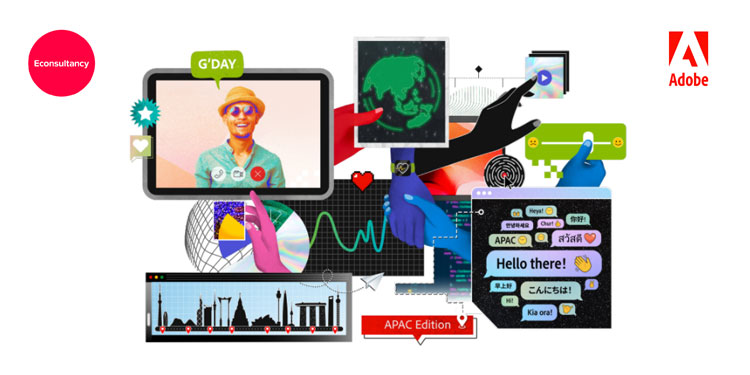New Delhi: Asia Pacific businesses are set to outstrip other global regions in customer experience investment in 2022 in response to a pandemic-induced surge in new digital consumers and online behaviors. However, APAC businesses recognize that critical skills and capability gaps may hold them back as they seek to maximize this world-leading commitment to serving digital-first consumers.

“The digital rewiring of consumer mindsets in the Asia Pacific has been of high benefit to those businesses who have embraced an agile digital mindset, purposeful collaboration, and sped up their time-to-value ratio.” said Duncan Egan, Vice President Digital Experience Marketing, Adobe Asia Pacific & Japan.
“Companies that overcame organizational and technology silos to work cross-functionally, were able to drive meaningful customer experiences that are personalized, real-time, relevant and connected across all channels.”
Gaining visibility of new digital and mobile-first consumers
According to Adobe’s new 2022 Digital Trends: APAC in Focus report, 77% of APAC businesses experienced a surge in new customers through digital channels over the past 18 months, and 76% saw new customer journeys. Meanwhile, just 25% of businesses believe they have significant insight into this new wave of digital-first customers.
Contributing to these new online behaviors are the 130 million new APAC mobile subscribers that became first-time internet users in 2021[1]. These new mobile-first users in emerging APAC economies are ‘leapfrogging’ consumers in more mature digital markets, rapidly adopting advanced digital behaviors such as mobile payments usage.
In a bid to meet new customer expectations, the majority of APAC businesses are stepping up investment in customer experience management (59%), edging ahead of North America (57%) and Europe (53%). Most APAC businesses also expect to accelerate investment in customer data technology (60%).

“Understanding and serving a new breed of online consumers, many with mobile-first preferences, has become the new competitive battleground for APAC businesses. While many organizations are responding decisively by fast-tracking investment in improving the digital experience, spend alone is unlikely to set the leaders apart,” said Scott Rigby, Chief Technology Advisor, Adobe Asia Pacific and Japan.

Akshay Tapase, SVP, Digital Marketing, AU Small Finance Bank said, “Recent years have unearthed some compelling reasons for the Indian banking sector to undergo a digital makeshift. New and existing new consumers are joining the digital wave for the first time with increased access to smartphones and the internet resulting in the rise in expectation of higher standards of reliability and the convenience of mobile banking. Therefore, having a sound mobile strategy only adds to our commitment to provide a digital-first and innovative banking experience to our customers.”
Building capability by overcoming legacy constraints
APAC’s pursuit of global leadership in digital customer experience and ensuring a return on elevated investment relies on the skills and agility to deliver. Yet the report shows that, on average, APAC businesses lag their global counterparts in these crucial operational capabilities.
According to the report, 83% of APAC businesses leaders are worried that their organization doesn’t have the necessary skills they need, compared to 79% in Europe and 73% in North America. In addition, digital skills rank as the joint top barrier to digital experience delivery together with poor integration between tech systems.
APAC businesses may also be leaving viable talent attraction and retention opportunities on the table. In a world where remote and flexible working is commonplace, Forrester outlines that only 40% of business leaders intend to make remote work permanent compared to 70% globally[2]. Similarly, the Adobe report shows that only 1 in 4 leaders expect hybrid work to remain elevated, while just 19% plan to hire remote workers at levels higher than before the pandemic. With a global constraint on the availability of digital talent, not embracing remote working is going to further constrict supply and further delay businesses’ digital transformation goals.
While 92% of APAC leaders ‘agree’ that their ability to be agile will decide their success as a marketing organization, just 25% of practitioners rate their organization’s agility in responding to opportunities and disruptions as positive (8 or more out of 10).
“Given that 83% of APAC organizations expect the rate of technological and social change to continue at the same or higher levels, developing the skills, agility, and innovation required to keep pace should remain a top strategic priority,” said Rigby.
The advantages and disadvantages of digital maturity
The closer examination of businesses in Australia and New Zealand, Asia, and India, shows unique opportunities and challenges.
For the comparably more digitally advanced Australian and New Zealand markets, simplifying their technology stack is a priority for 1 in 3 businesses, far more than in Asia (13%) and India (24%). Poor integration between systems is also ranked as the top factor holding back marketing organizations in Australia and New Zealand, illustrating the potential drawbacks of longstanding digital legacies.
However, businesses based in India are more likely to be seeing new digital customer behaviors as new internet users emerge. They have a greater focus on artificial intelligence to deliver experiences than others in APAC, and more practitioners in India consider their innovation capabilities and collaboration with technology teams to be strong.
Asian businesses rate a lack of skills as their top barrier and are prioritizing development as a result. Compared with practitioners from Australia and New Zealand and India, substantially more Asian respondents see room for improvement in innovation capabilities and gaining customer insights.
Key Data Points – India
- 33% of Indian practitioners interviewed felt their digital experience lagged customers’ expectations
- 63% of Indian practitioners felt that they significantly or slightly outperformed their sector (vs 50% in ANZ)
- Indian brands had an even viewpoint on barriers holding back their CX organizations: 35% across poor integrations, lack of skills, workflow issues, and customer insights.
- 57% of companies were focusing on training and learning to increase productivity
- 45% of businesses had clear insights into drivers of purchase vs. 33% for customer friction points
Key Data Points – Asia
- 45% of Asian interviewees said that their digital experience lags customer expectations (45% said it kept pace)
- 51% of Asian businesses said they either kept pace or slightly/significantly underperformed their sector
- 50% of brands feel that the biggest obstacle holding them back was digital skills and capabilities
- 55% thought that investing in work & project management would be key to drive productivity
- Asia’s ability to obtain customer insights is well behind ANZ & India, with only 18% on average admitting to having customer insights across new customer journeys, friction points, loyalty and drivers of purchase
Key Data Points – Australia and New Zealand
- 81% of ANZ brands expect the pace of change to persist (vs 84% rest of APAC)
- 77% of ANZ saw new and changing journeys vs 70%
- 87% of ANZ customers said their CX either lagged customer expectations or kept pace (34%/53%) vs 13% that thought they were ahead
- We are finally seeing a maturity in ANZ customers with their top marketing goals for 2022 being customer retention 52%, vs acquisition at 47%.
- 77% of ANZ execs are concerned their employees don’t have the right skills necessary to deliver effective digital experiences.
- Poor integration between tech systems is holding marketing/CX back, with 48% of ANZ businesses saying this is a priority, followed closely by Workflow issues at 40%
- Add to this simplification and standardisation of the tech stack (33%) is a focus
- ANZ is leapfrogging the rest of APAC in its appetite to use cloud-based techfor CX & data management (56% vs 37% in Asia). Asia is more likely to develop its own platform or use multi vendors with no unifying platform.
Download the full 2022 Digital Trends: APAC in Focus report here.
[1]GSMA, Digital societies in the Asia Pacific: Accelerating progress through collaboration, 2021
[2]Forrester, Predictions 2022: Edition APAC, 2021

















